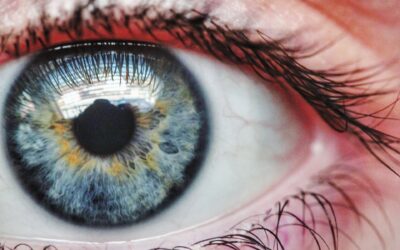Arthritis is a painful condition stemming from inflammation of the joints, resulting in irritation and stiffness including, but not limited to, the fingers, wrists, knees, ankles, toes, shoulders, and neck.
Inflammation in the body often spills over into the eye as well, and therefore those who suffer from arthritis are also at a higher risk for various eye conditions including denser cataract development, glaucoma, scleritis, and uveitis.
Don’t worry, we’ll get into all these specifics in a bit. For now, let’s start from the beginning with understanding what arthritis is.
Arthritis
Arthritis is typically thought of as an aging disease; while it does become more prevalent in the later years of life, it can occur at any age.
There are three main categories of arthritis–osteoarthritis, rheumatoid arthritis, and psoriatic arthritis.
Osteoarthritis is the most common type of arthritis. It is best known as the “wear and tear” arthritis best correlated with the natural aging process. It occurs when the cartilage that cushions the joints breaks down, resulting in little protection against the bones grinding against each other.
Rheumatoid arthritis is an autoimmune disease, meaning the body attacks itself. Rheumatoid arthritis has been well-known to attack the thin layer encasing cartilage of the joints, blood vessels, eyes, heart, lungs, and more.
In rheumatoid arthritis, the body incorrectly targets an area as “infected”. It then ramps up an immune response–which includes upregulation of the inflammatory cascade and production of B cells (an immune system cell).
B cells have a secondary role of increasing production of osteoclasts–specialized cells that break down bone material. Elevated levels of B cells over extended periods of time can result in fragile bones, making it easier to fracture or break bones–another common finding seen with chronic rheumatoid arthritis.
Psoriatic arthritis is associated with psoriasis–the skin condition that is known to cause scaly, flaky, itchy skin. In fact, recent studies have shown that roughly 30% of individuals with psoriasis will develop psoriatic arthritis.
The exact mechanism of psoriatic arthritis is currently unknown. What we do know is that in psoriatic arthritis, the body is chronically inflamed, meaning the joints in various parts of the body become irritated and painful.
Psoriatic arthritis has a few tell-tale signs that help differentiate it from the other types of arthritis. It is often seen in younger individuals, may cause pitting or separation of the fingernails from the nail bed, and may cause fingers and toes to swell up, taking on a “sausage-like” appearance.
Psoriatic arthritis can be further classified into 5 sub-types: asymmetric psoriatic arthritis, symmetric psoriatic arthritis, distal psoriatic arthritis, spondylitis, and arthritis mutilans.
Arthritis and Cataracts
Regardless of the specific type, all arthritis cases result in elevated levels of inflammation within the body.
Increased inflammation within the body for a few days will not typically cause a problem, however years and years of inflammation can wreak havoc on the body, including the eyes!
Within the eye we have a structure called the crystalline lens. The lens is a translucent, flexible structure that helps to bend light appropriately to create clear images.
As a natural part of aging, cells and proteins within the lens start to clump together and lose their translucency. The lens therefore begins to become cloudy and yellow in color. The cloudy, yellow, inflexible lens is called a cataract, which will need to be removed in order to restore vision.
Cataracts will occur in everyone. Early signs of lens changes can often be seen around the age of 55. These changes will continue to progress until cataract surgery is implemented to remove the lens. The average age of an individual undergoing cataract surgery in the United States is currently 73 years old.
In individuals with arthritis, cataract surgery may be needed as early as 50 or 60 years old. This is because the inflammatory cells increase the rate of breakdown of lens cells and proteins.
Additionally, many individuals with arthritis take steroid medications as treatment. Steroids have been linked to faster progression of cataracts and thus require close monitoring of ocular health if on this type of medication for more than a few months.
Arthritis and Glaucoma
Glaucoma is an eye disease affecting the optic nerve of the eye. The optic nerve is essentially the cable that connects the eye to the brain. If the cable becomes damaged, information cannot be transmitted and the brain will not be able to process images correctly (seen as a permanent loss of vision).
Arthritis can cause glaucoma secondary to excess inflammation within the eye.
One of the mechanisms of glaucoma is that a person’s eye pressure becomes too high, putting stress on the back of the eye. Prolonged periods of high pressure can essentially pinch off the optic nerve, causing parts of it to die, resulting in vision loss.
Eye pressure is created via the flow of aqueous humor into and out of the eye. Aqueous humor is the liquid that fills the eye–it enters at the equator of the eye and then flows out through porous channels near the front of the eye.
Inflammatory cells are small enough that they can enter the eye, but are sticky and can conglomerate along the openings of the porous channels, creating a blockage to aqueous humor outflow.
When aqueous humor cannot exit the eye, it builds up, increasing pressure bit by bit and adding stress to the optic nerve. The more stress on the nerve, the more damage is done, and the nerve slowly dies off (i.e. glaucoma).
Arthritis and Scleritis
Scleritis is a term used to describe inflammation of the sclera–the white part of the eye.
Scleritis is very painful, and presents with red eyes, light sensitivity, blurry vision, and boring pain (especially on eye movement) that seems to come out of nowhere.
Scleritis is related to arthritis in the fact that arthritis can attack/affect the eye. More specifically, arthritis causes inflammation within the sclera.
Scleritis can be seen in individuals who do not have arthritis as well, however risk for an outbreak of scleritis is higher in those who have some form of arthritis. This is especially true for recurring scleritis.
There is even a unique form of scleritis that is only seen in individuals with rheumatoid arthritis–this form of the disease is called scleromalacia perforans. In scleromalacia perforans, autoantibodies associated with rheumatoid arthritis target the sclera of the eye, slowly destroying it from the inside out.
Fortunately, scleromalacia perforans is rather rare. However, it can be quite visually destructive, and for that reason it is of the utmost importance for an individual with rheumatoid arthritis to have regular eye exams and call their eye doctors ASAP if something seems wrong with the eyes.
Uveitis is an inner eye infection caused by inflammation of the middle layer of the eye–the uvea. In uveitis, normally non-fenestrated blood vessels leak inflammatory cells into the anterior chamber (the frontmost cavity of the eye containing aqueous humor).
This inflammation can be quite uncomfortable, resulting in eye pain, redness, light sensitivity, and blurry vision. As noted earlier, inflammatory cells do not belong inside the eye. They are quite sticky and can cause damage to eye structures.
One such example of this is formation of synechiae. Essentially, the sticky inflammatory cells cause the iris (colored part of the eye) to stick to the crystalline lens (posterior synechiae) or the drainage area of the eye (peripheral anterior synechiae).
If synechiae form a 360 degree block, it can cut off the flow of aqueous humor, resulting in something called “acute angle closure”. In acute angle closure, eye pressures sky rocket to dangerously high levels resulting in extreme pain, nausea, dizziness, headaches, etc. and can be a threat to vision if this pressure is not relieved quickly.
For this reason, it is important to have potential eye infections managed promptly by an eyecare professional, so he/she can carefully watch for and treat synechiae before an acute angle closure occurs.
Arthritis Treatments and the Eye
Last but not least, many treatments for arthritis can be damaging to the eye.
One of the most common medications prescribed for arthritis management are steroids. In fact, if a patient has scleritis or uveitis, steroids are part of the first line treatment to manage these eye infections!
However, steroids and the eye are not always friends. Prolonged steroid use can cause early onset cataracts in some individuals. Additionally, steroids can occasionally cause eye pressures to increase, heightening the risk for glaucoma development.
Another common medication taken to treat arthritis is hydroxychloroquine (Plaquenil). While this medication works wonders on reducing inflammation within the body, it is known to cause changes within the retina of the eye in roughly 5-20% of individuals taking it (depending on dosage and how long an individual has been on the medication)
For this reason, any individual taking hydroxychloroquine for more than 6 months needs to be screened and monitored yearly to watch for these retinal changes and prevent permanent vision loss.
If you or someone you know suffers from arthritis, be sure to chat about it with your eye doctor at your next appointment. While most individuals may not have eye-related issues secondary to arthritis, it is highly possible.
Understanding the risks and associations between arthritis and the eye can help an individual to be more careful, watching for possible signs and symptoms of an eye problem. When it comes to the eyes, it is always better to get treatment earlier rather than later!
If you, or someone you know, thinks they may be suffering from an eye infection or irritation secondary to arthritis, be sure to give us a call today.





